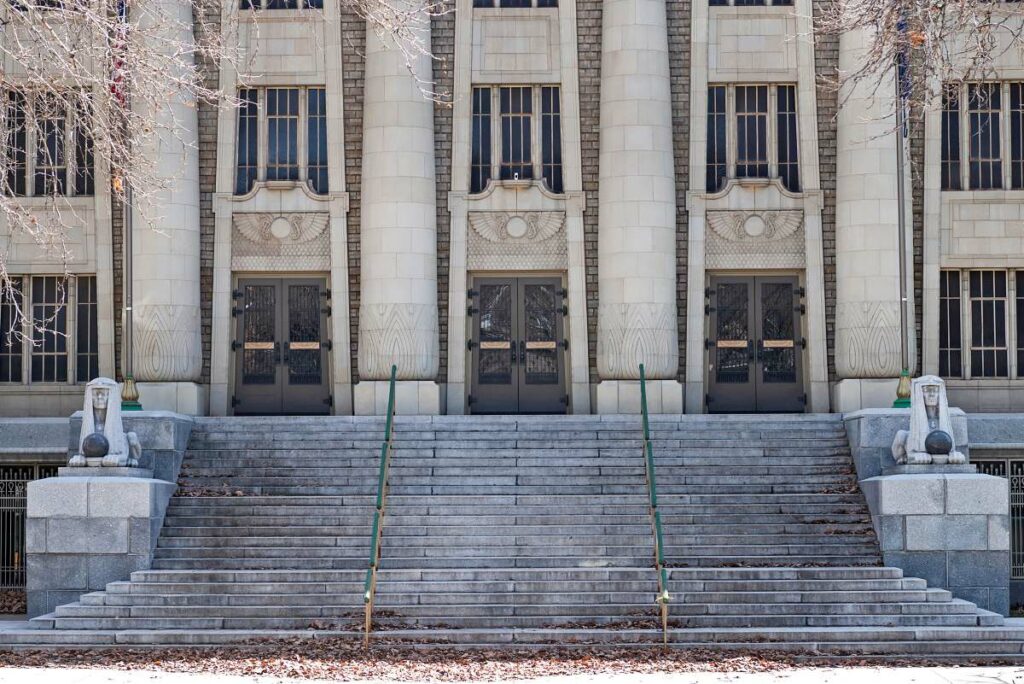
The grand Salt Lake City Masonic Temple graces South Temple with Egyptian-revival architecture. It features stately sphinxes at its entrance guarding marble globes. Its imposing tower, intricate stonework, and pointed arches add up to one of the most important Egyptian-revival samples in the state. It has graced the landscape here since 1927. South Temple was once the city’s main thoroughfare going east and west. The temple occupies a prestigious piece of real estate at 650 E. South Temple, Salt Lake City, UT 84102.
There is a calm in this corner of the world. It features lush, old trees, churches representing multiple faiths, eclectic shops, and eateries. This historic neighborhood seems oddly (and deliciously) urban.
What’s a lovely sphinx like that, doing in a place like this?
So, how did this stunning architectural Egyptian-revival wonder come to be in the heart of Salt Lake City? The entire city was disproportionately occupied by members of the Church of Jesus Christ of Latter-day Saints when it was constructed.
Ironically, the first Masonic Lodge in present-day Utah was formed by American soldiers who had come to control the Mormons in 1959 at the behest of President James Buchanan. The Mormon rebellion wasn’t quite all it was cracked up to be author Michelle Hill said in an article, Utah’s First Masonic Lodge, published by Utah Humanities online. The tale is part of a collection called, “Utah Stories from the Beehive Archive.”
Hill said, “The soldiers, who came as part of Johnston’s Army expecting to quash a rumored Mormon rebellion, found life somewhat dull after the excitement of marching into Utah. They established their base about fifty miles southwest of Salt Lake, named it Camp Floyd, and quickly discovered they had very little to do. Some soldiers organized choirs and acting troupes to relieve the tedium, but one group banded together to establish a Masonic Lodge.”
Hill said 23 soldiers from Camp Floyd requested a charter from the Most Worshipful Grand Lodge of Missouri, and received approval in April 1859 to organize the Rocky Mountain Freemason Lodge No. 205. They built the first Masonic meeting hall in Utah, a 60-foot by 30-foot adobe structure.
Hill said, “At least 162 men became Masons during the Lodge’s short time of operation. They did charitable work, such as giving aid to western-bound migrants. The Masons also faced resistance from their fellow soldiers, some of whom considered the secret nature of Freemasonry to be grounds for dismissal from the Army.”
In 1861, the Civil War broke out and the soldiers were sent to the East. The Rocky Mountain Lodge No. 205 was disbanded.
Masons pressed on in Salt Lake City
The Masons carried on in present-day Utah. They occupied five other homes before the Salt Lake Masonic Temple was completed.
The Grand Lodge of Utah was formed in 1872. The Masonic membership grew substantially through the early settlement years. This temple was the seventh the Grand Lodge occupied. Increasing membership numbers made it clear that a new, permanent home was overdue. A building committee was formed to assist architect Carl W. Scott with researching designs and methods used by other organizations.
According to a Wikipedia article, Salt Lake Masonic Temple, published online on Aug. 8, 2022, there were multiple reasons leaders opted for the Egyptian Revival motif. A building committee researched the project for years before it was set in stone.
- The Egyptian style was all the rage in the 1920s.
- The motif was unlike any other Masonic temple and would bring notoriety to the Masons’ new home.
- Many Masonic symbols needed to be incorporated into the design. The Egyptian motif made it possible to incorporate them without disrupting the “harmony of the edifice.”
- Masonic symbolism could be used discretely in the intricate design required to create a historic example of the chosen architecture.
Neighborhoods surrounding the Masonic Temple
Capitol Hill: To the east of the Masonic Temple is the Capitol Hill neighborhood. It’s known for its stately historic homes and stunning views of the city. The neighborhood is home to the Utah State Capitol building, which is located just a few blocks east of the temple.
West Capitol Hill: To the west of the temple is the West Capitol Hill neighborhood, which is known for its rare mix of historic homes, trendy restaurants, and shops. The neighborhood is also home to the Salt Lake City Public Library, which is located just a few blocks west of the temple.
The Avenues: To the north of the temple is The Avenues. It’s known for its tree-lined streets, charming homes, and jaw-dropping views of the city and the mountains. In The Avenues, you will find many parks and hiking trails, as well as multiple historic landmarks.
Central City: To the south of the temple is the Central City neighborhood. You know that pulse you feel just outside the city center? It comes from the heart, and Central City is the heart of Salt Lake. Diversity is celebrated here and more evident than it is anywhere else in the entire state of Utah. The cultural scene is alive and bursting with excitement. It features a vibrant art scene too. The Central City Neighborhood is home to several theaters and performance venues, as well as a number of galleries and museums.
All of these neighborhoods are within walking distance of the Salt Lake City Masonic Temple, and each offers unique character and charm.
Not just another pretty Egyptian face
The Masons are a group of men who share a commitment to moral and ethical values, and who are dedicated to helping their fellow human beings. The Salt Lake City Masonic Temple is the headquarters for the Grand Lodge of Utah, which oversees all Masonic activity in the state. The temple’s central location makes it ideal for events and activities including weddings, concerts, and other cultural events.
Inside the temple is an array of architectural features including stained-glass windows, ornate carvings, and intricate tile work. The temple’s main auditorium is a spacious and elegant room that is ideal for concerts and other performances. The auditorium features a massive pipe organ that was built by the W.W. Kimball Company of Chicago and is considered one of the finest organs in the world.
In addition to the auditorium, the temple also houses a number of other rooms and facilities that are available for rent. These include a ballroom, a dining hall, and several smaller meeting rooms.
A vast library is tucked away here
One of the most impressive features of the Salt Lake City Masonic Temple is its library. The library is home to a vast collection of books, manuscripts, and other materials related to Masonic history and philosophy. The library’s collection includes rare and valuable books that are not available anywhere else, making it a must-visit destination for scholars and researchers.
The temple’s museum is also a fascinating place to visit. The museum houses artifacts related to Masonic history, including regalia, furniture, and other items. Visitors can learn about the history of the Masonic fraternity and its impact on society, as well as the role that the Masons have played in shaping the history of Salt Lake City and the state of Utah.
Masonic Temple faced demolition
The Masonic Temple is grand. That is evident from the bottom of one of the most striking sets of stairs I have ever seen. Make no mistake, hard times have fallen on this national treasure too. In the 1980s, the temple was in danger of being demolished to make way for a new office building. However, a group of concerned citizens rallied to save the temple, and it was added to the National Register of Historic Places in 1987.
Since then, the temple has undergone renovations and restorations to ensure it remains a vital part of Salt Lake City’s cultural landscape. If you’re interested in history and architecture, the Salt Lake City Masonic Temple is definitely worth a visit. Whether you’re a Mason or simply a curious visitor, the temple’s impressive architecture, fascinating exhibits, and beautiful surroundings are well worth the time.
If you have questions about homes in any community surrounding the Salt Lake City Masonic Temple, please call or text me at 801-673-3333.

